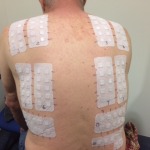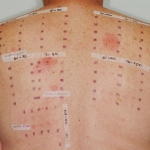Introduction to Contact Allergen Bank Australia
Contact Allergen Bank Australia (CABA) is based on an idea which originated in Denmark and is a new initiative in Australia to assist dermatologists to diagnose allergic contact dermatitis (ACD). It involves the preparation of individualised patch tests which are sent out to dermatologists’ practices.
Project aims:
- To provide Australian dermatologists, particularly those in regional centres, with access to comprehensive patch testing resources, available in a timely manner
- To improve the prognosis of patients with contact dermatitis, with the identification of allergens relevant to their skin condition
- To collect data on the results of patch testing nationally
- To enable dermatologists to develop experience and expertise in contact dermatitis, without the costs of purchasing allergens or paying for nursing staff
Dermatologists select patch test series that they would like to test on a particular patient. The patch tests are then prepared at the Skin Health Institute and mailed to the dermatologist, together with a test sheet, prepared from our computerised patch testing program, PatchCams©. The dermatologist subsequently reports the patch test reactions to the centre for recording in our database. This process is now available online. Once you have registered for CABA you will be given access to the website. In addition, the patient information sheets for more than 70 allergens will be available on the PatchCams© website.
Any questions or to Register for CABA, please ph. 03 9623 9402 or email [email protected]
Time of receiving allergen order:
Please allow up to a week for order or longer if you are based in a regional or rural area. When ordering allergens please specify what date you plan on applying the patches to the patient, so they can be prepared and sent accordingly. If this request can’t be met, you will be notified.
Storage of patches
Store patches in fridge or in a dry, cool place, away from direct sunlight.
What to order:
Generally we recommend that all patients are tested with the Australian Baseline Series (ABS), which has recently replaced our standard and supplementary series. This series contains the most common causes of allergy seen in Australia, and contains a wide range of allergens including, nickel, fragrances, preservatives, rubber ingredients, ingredients from medicaments and cosmetics, dyes, hair dyes and bleach.
In addition, we recommend you add tests that are relevant to the patients’ rash or occupation. We have almost 50 additional series that you can choose from.
Refer to “What allergens to order” tab for more information.
For full lists of individual allergens you must be registered with CABA. To assist you when dealing with occupational cases, we have developed a list of occupational groups we commonly see, and have suggested recommended test allergens and series. Similarly we have a comprehensive list of recommend tests for general causes of contact dermatitis. These lists are available in PatchCams©
Note about liquid allergens: These are pre-loaded due to the use of PatchTransport® containers. The patches may appear dry, but rest assured the allergen has been applied.
Life of the patches
It is recommended that the patches are used within a week of receiving them. This is due to the fact that some allergens are unstable, so be sure the tests are of best quality, please use within this time frame.
Placement of patches
The patches are most commonly positioned on the patients back, in 2-3 rows across the top of the shoulder, down to mid back line. See below for suggested positioning.

Reading of patches
Reading of patches is performed on day 2 and 3. The reading is performed 10-15 minutes after patches have been removed. Once patches are removed, the purple marks are re-touched, and the patches are numbered with thin pieces of tape, as seen in example 2.

Along with the strength of the reaction being recorded, the relevance of the reaction must also be determined. Please record results on patient chart (and in the PatchCams© database, on the clinic screen where chart was made and saved), and state their relevance. There are 3 different categories of relevance:
Use ‘U’ on the keyboard = Unknown relevance
Use ‘R’ on the keyboard = Relevant reaction
Use ‘O’ on the keyboard = Old or past relevant reaction
Patient handouts
We have compiled several different brochures in PDF format that you may like to use throughout the patch testing process. There are also hyperlinked information sheets for all allergens as well, which you will have access to, once registered for CABA.
About patch testing
This brochure can be printed and distributed to patients before patch testing, as it provides an outline about patch testing procedure, and how to prepare for patch testing.
Do and don’t information sheet
This sheet can be printed and given to patients after their patches have been applied, and provides similar instruction to patient about things to avoid during testing.
We have made available a large number of allergen information sheets, that you may like to print and distribute to patients when they have had a positive patch test. These will soon be available in PDF format at www.patchcams.asn.au
In addition to the allergen sheets, we have several information sheets that will assist in explaining the different diagnosis to the patients. These will also be available on the above on the above website.
- Diagnosis flow chart. This is a pictorial, flowchart style diagram which assists in explaining the different diagnoses an individual may be diagnosed with, following the completion of testing.
- Latex allergy. Basic overview about latex allergy and what it is, things that may contain latex, signs and symptoms and useful links where further information is available.
- Eczema. Overview about eczema, factors that may aggravate eczema and management strategies.
- Allergic contact dermatitis. Summary about what allergic contact dermatitis is, what the common causes are and risk factors.
- Irritant contact dermatitis. Summary about what irritant contact dermatitis is, signs and symptoms, common causes and high risk occupations.
- Contact urticaria. Describes what contact urticaria is, common causes, and diagnosis of the condition.
- Guidelines for people with atopy. Outlines risks for people with atopy, high-risk careers and good skincare measures.
For more information about Contact Allergen Bank Australia, please email [email protected]
